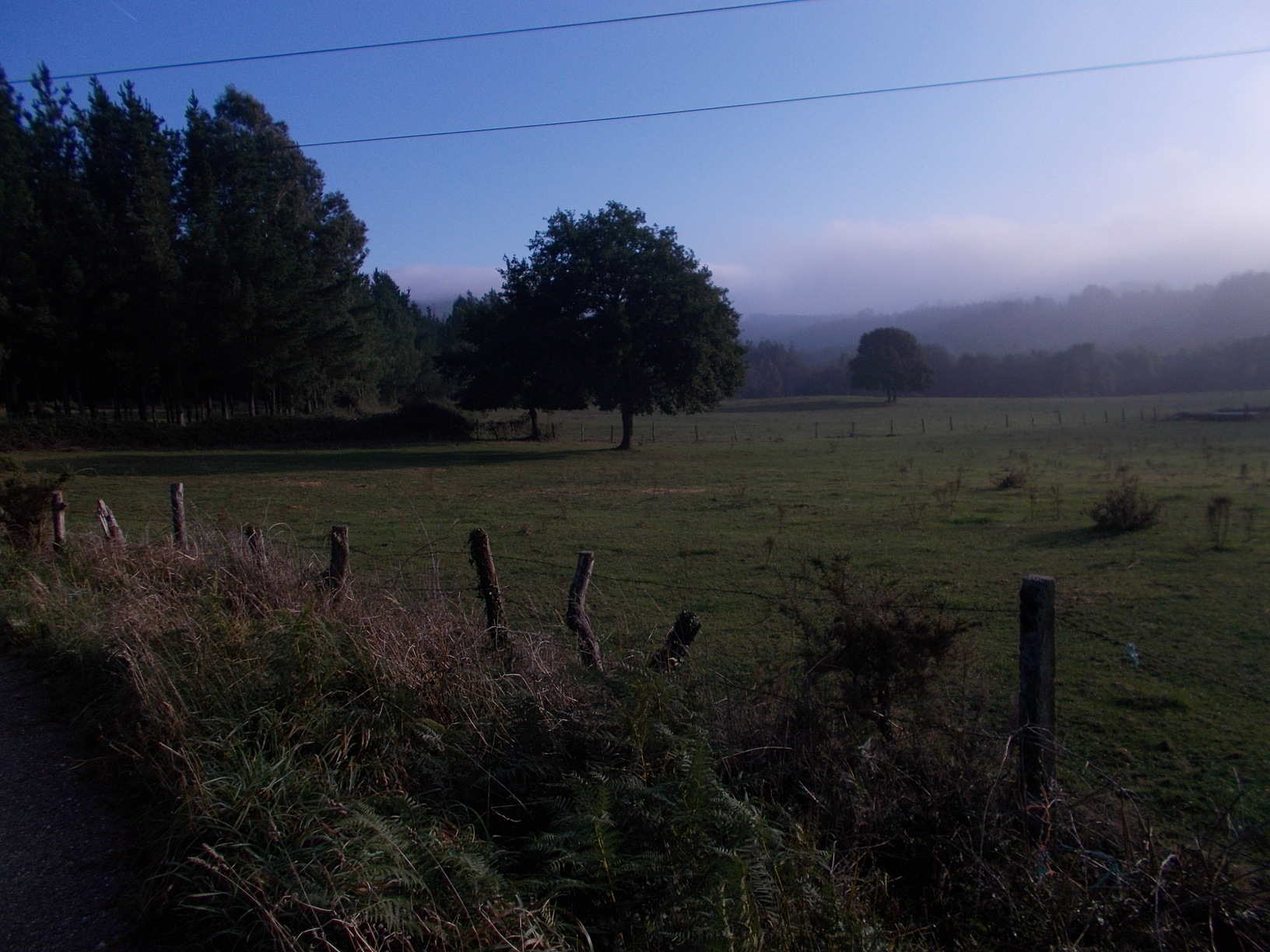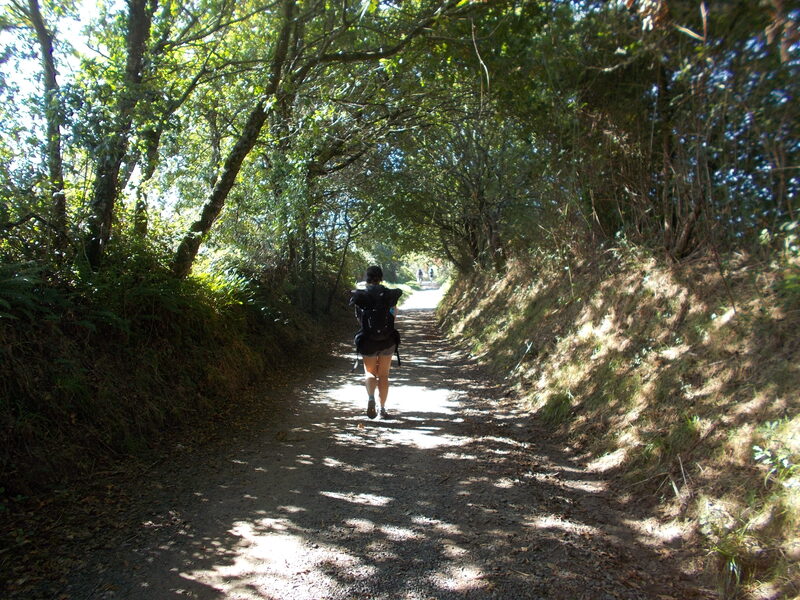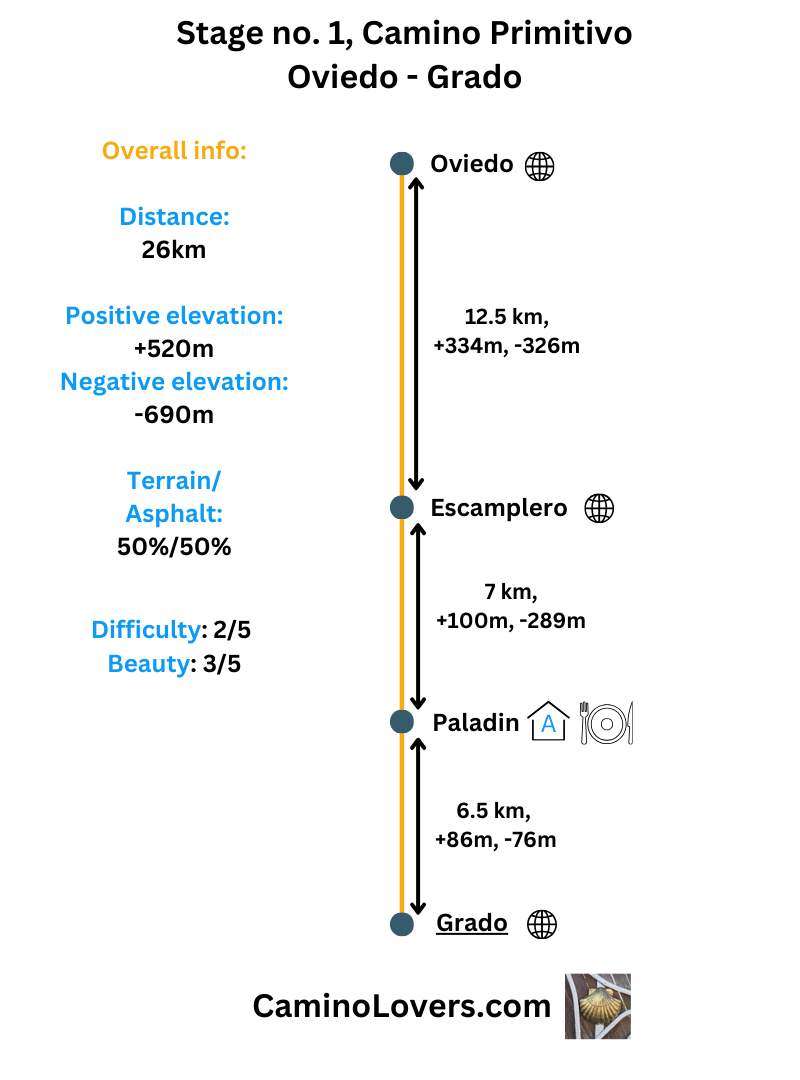
Table of Contents
Basic Details
- Starting point: The Cathedral of Oviedo (you can get your pilgrim passport (credential) in the cathedral, more info here).
- Ending point: The city center of Grado (a town in Asturias with roughly 10,000 inhabitants, two pilgrim hostels and other accommodation options, and all services).
- Availability of alternative routes: Not really, there are a few other way-marked routes from Oviedo to Grado (yellow and white stripes), but they either aren’t nicer than the official route, or add too many extra kilometers to the walk. Hence I recommend following the official camino.
- Distance: 26 km (download GPS here)
- Link to online map: Official camino route: here.
- Elevation difference: + 520m, – 690m.
- Difficulty score: 2/5.
- Beauty score: 3/5.
- Terrain/asphalt: 50%/50%. Good news is that in contrary to leaving many other big cities on the Camino, the official route of Camino Primitivo doesn’t coincide with any frequented road out of Oviedo. Hence you do not have to worry about noisy traffic or any danger related to it.
- Next stage: Camino Primitivo, Stage no. 2, Grado – Bodenaya.
- Previous stage: Camimo Primitivo, Stage no. 0 (connecting from Camino del Norte), Vilavicossa – Oviedo.
Elevation profile for route
 – A relatively easy (26 kilometers is never entirely easy :)) stage to start your Camino Primitivo with. As you can see, there’s just one bigger climb in the middle of the walk, where you climb almost 140 meters on a single kilometer. The descent is more gradual and the last few kilometers to Grado are really pleasant. Overall an easy elevation profile, when compared to some other stages of Camino Primitivo.
– A relatively easy (26 kilometers is never entirely easy :)) stage to start your Camino Primitivo with. As you can see, there’s just one bigger climb in the middle of the walk, where you climb almost 140 meters on a single kilometer. The descent is more gradual and the last few kilometers to Grado are really pleasant. Overall an easy elevation profile, when compared to some other stages of Camino Primitivo.
Advanced info about the stage
- Trail marking: Tricky in Oviedo, at the very start of your Camino, since from here there is also a marked way leading northwards towards the city of Aviles, on Camino del Norte, on the coast. You may wonder why. Well, the reason is simple–some pilgrims prefer seeing Oviedo and avoiding the ugliest stage on Camino del Norte from Gijon to Aviles. Hence they leave the coastal way in Vilaviciossa, walk to Oviedo, see the city, and then head back north to the coast, to reconnect with the coastal way in Aviles. For you (walking the Primitivo) it isn’t really important, just you should know that both ways are marked with the same yellow arrows, and one can easily make a mistake (especially on some foggy day), walking in the direction of Aviles instead of in the direction of Grado. I’ve heard this story many times… Hence it is pivotal to be careful at the beginning and ideally check things with your phone (or follow the GPS you can download from our website). Once you’re out of Oviedo, you’re safe and should not get lost, since the marking is really good with plenty of yellow arrows.
- Natural places worth seeing: Nothing worth a special mention. The route today has nice views, but there aren’t really any spectacular viewpoints or any places that would be worth some detour. Probably the nicest part (nature wise) is just before Escamplero, where you walk close to the River Nora (Rio Nora), and then 3 kilometers after Escamplero, where you get close to another river, Rio Andallon. In this zone you can see some remains of an ancient water mill, and there is also a cave which is an archeological site, called Cueva Oscura de Ania (they do not show it on most maps, but if you’re into archeology and caves you can read more about it here)
- Historical, architectural, and culinary places worth seeing:
- Obviously the city center of Oviedo, with Cathedral of San Salvador of Oviedo as a highlight (paid entrance). But there are plenty of historical buildings and a lot to observe for any architecture lover in the old town Oviedo. Not worth an extra day in the city in my view, but for one afternoon it is an excellent place to visit for any pilgrim.
- The reconstructed medieval bridge, located here. Right on the Camino, 9 kilometers out of Oviedo. A nice spot, you can actually take a small detour from there following the river either up-stream or down-stream (there’s a paved way), it is a nice green area with some interesting meanders.
- Palacio de Miranda Valdecarzana, right in the center of Grado, here. Nice from both outside and inside, they have some art expositions on display all year round. Free entrance, open daily until 8:45pm, with the exception of July and August, when they close pretty early at 2:30pm and hence visiting the place is an option only if you arrive early to Grado.
- Camping/bivouac options on this stage: Not good at all to be honest. A lot of fences and private property along the route, and no official or organized camping places. If you have to camp, however, I’d suggest either the zone of the meanders of River Nora, around here, you can leave the Camino at the medieval bridge and try to find a good spot close to the river, or you can try your luck in the forested zone north of Grado, climbing a kilometer or two out of town and trying to find a good spot that isn’t a private property. Overall though this isn’t a good stage for wild camping or bivouacking.
- Dog friendly score: 4/5. A very decent stage for dogs. Plenty of shade, several river crossings or being close to the river where your dog can both drink and cool itself down. The roads aren’t busy with traffic. What’s more, one of the pilgrim hostels in Grado accepts dogs, it is called Albergue la Quintana, and you can check the location on Google maps here. They also accept reservations on Booking.com, hence you can book in advance and make sure you’ll have a place to stay with your doggie :).
- Special remarks:
- Some pilgrims feel a bit of a letdown on this stage. Camino Primitivo is often promoted as a “mountainous Camino“, and hence many people expect minimum of asphalt walking, and some great mountains right from the beginning. This isn’t true though. First of all, you will have a few stages with minimum of asphalt walking and some nice mountains. But you need to reach them first :). And secondly you have to realize that Camino follows (at least most of the time) the route ancient pilgrims used to follow, which is always the route of least resistance. That means you cannot expect any Camino to take you over one mountain ridge after another. It doesn’t mean that Primitivo isn’t a beautiful Camino. It is very nice, especially the part between Grado and Lugo. But it is better to keep your expectations low (and be nicely surprised), and to get on peace with the fact that you’ll have quite a lot of asphalt walking on this way too, just like on any other Camino route. At least it isn’t that much, and the roads aren’t busy with traffic :).
Pictures from the stage
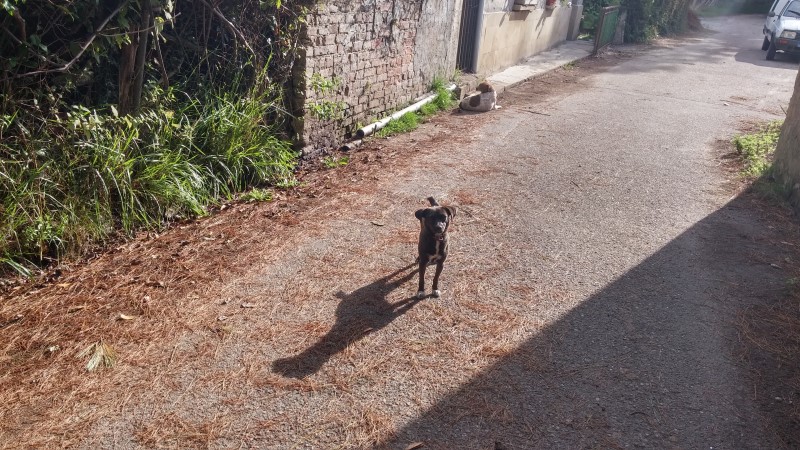 – A quick note to stray dogs on Camino Primitivo: They are not common, and very uncommon in the province of Asturias. While you will encounter some dogs on the streets, they aren’t really stray dogs, but household dogs who enjoy a bit of liberty. Mostly small dogs, and very friendly in general. No need to be worried about this aspect of the walk on the Primitivo way.
– A quick note to stray dogs on Camino Primitivo: They are not common, and very uncommon in the province of Asturias. While you will encounter some dogs on the streets, they aren’t really stray dogs, but household dogs who enjoy a bit of liberty. Mostly small dogs, and very friendly in general. No need to be worried about this aspect of the walk on the Primitivo way.
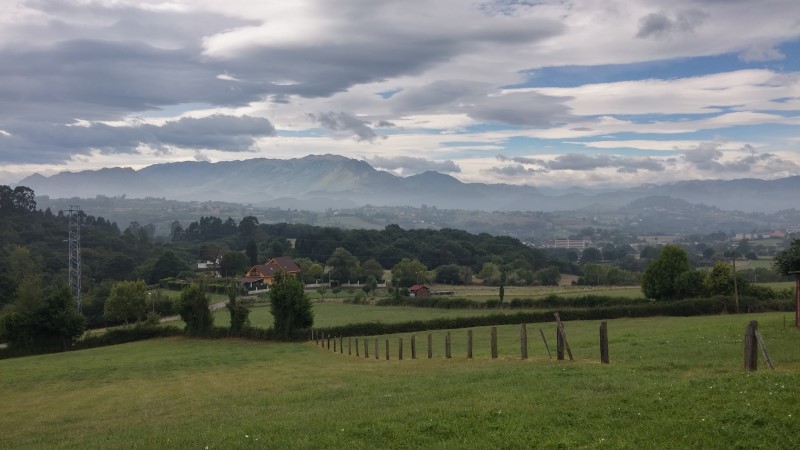 – Distant mountain ranges you will eventually reach and cross on your camino, in a few days from now.
– Distant mountain ranges you will eventually reach and cross on your camino, in a few days from now.
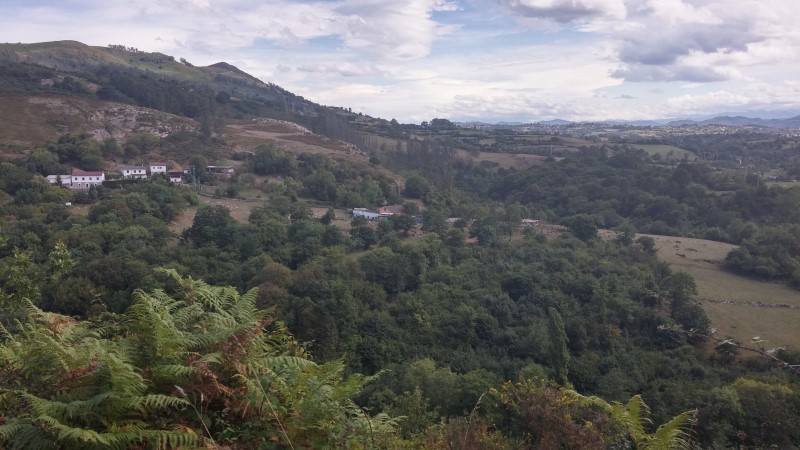 – A typical scenery of Camino Primitivo–small hills and a lot of vegetation. You will encounter such sights all along the route.
– A typical scenery of Camino Primitivo–small hills and a lot of vegetation. You will encounter such sights all along the route.
 – One of the many small hamlets on the way.
– One of the many small hamlets on the way.
 – Cows relaxing next to the Camino (behind a fence). Notice that they do not cut short their horns in Asturias (at least most of the time they do not), which is great for the well-being of the animals.
– Cows relaxing next to the Camino (behind a fence). Notice that they do not cut short their horns in Asturias (at least most of the time they do not), which is great for the well-being of the animals.
Few tips at the end
- If you do not speak any Spanish and this is your first Camino, I suggest you to consider staying at the albergue Hostel Villa de Grado (check location here). The place is run by the international fraternity of Camino de Santiago, and volunteers who run the place over the year are mostly either English or Dutch. And when they’re from other European countries they always speak English. I think it helps for an easy start for someone with little knowledge of Spanish language or the Camino.




![Ultralight Packing List for Camino de Santiago [2025 Edition]](https://caminolovers.com/wp-content/uploads/2022/03/altra-shoes-640-x-480.jpg)

